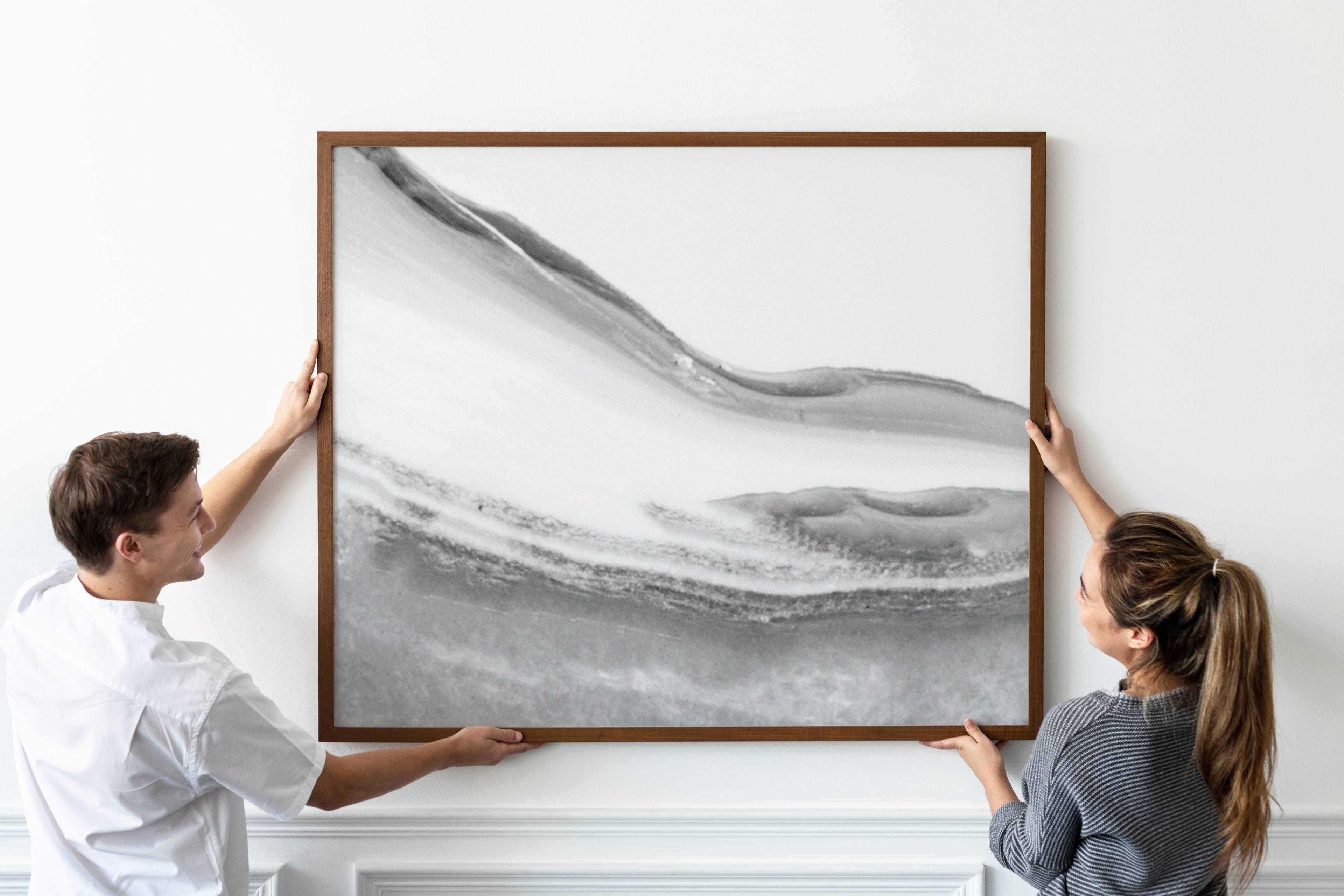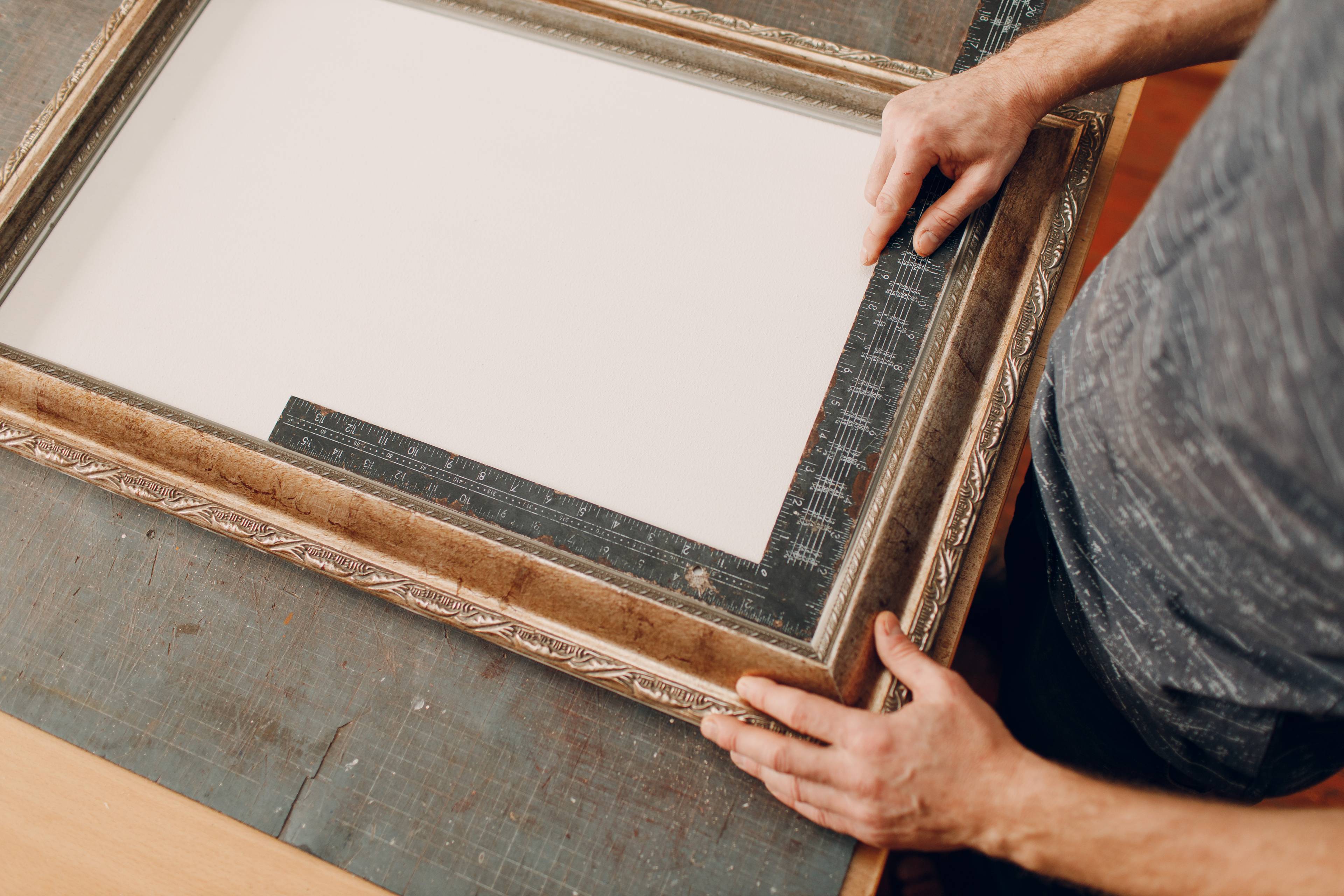Whether you're an avid collector or someone with a few cherished pieces, understanding the importance of art storage is essential. Using the right wrapping materials, avoiding harmful environmental factors, and choosing the right facility will ensure your framed artwork stays pristine.
Let's dive into our simple steps to ensure your masterpieces last a very long time!
Why do I need to properly store artwork?

Framed art is vulnerable to several factors that can compromise its appearance, structure, and overall value. These are:
- Environmental damage – Temperature and humidity changes can warp, mould, and deteriorate the artwork and its frame. High humidity is particularly harmful.
- Light exposure – Prolonged exposure to direct sunlight or intense indoor lights can fade colours and damage materials due to UV rays.
- Physical damage – Mishandling or accidents can lead to scratches, dents, and cracks. The glass in the frame can also break, risking damage to the artwork itself.
- Pests – Insects and other pests can harm framed art by eating the frame or directly damaging the artwork.
- Dust and grime – Dust, smoke, and grime build-up can affect the visual appearance.
By ensuring your art is stored in a cool, dry, dark place (with minimal temperature fluctuations) you can better preserve its condition.

Here are a few key benefits of framed picture storage:
- Protection from damage – A scratch here, a dent there, and suddenly your art looks a bit worse for wear. The right storage spot acts like a safety net.
- Environmental harm prevention – Like us, artworks aren't fans of too much sun or damp. Ensure they avoid direct sunlight, and keep the elements at bay.
- Value preservation – Whether it's the price tag or the sentimental value, keeping your art in great shape means it stays precious.
- Space organisation – A clutter-free space means a clutter-free mind. Storing art smartly means you can enjoy what you want to display without turning your space into a storage room.
Choosing the right storage unit

Choosing the right storage unit for your framed artwork, paintings, and prints is crucial. It will help yo preserve their condition and ensure they're kept safe and secure long-term. Here's what you need to consider:
- Climate controlled storage area – A climate-secure storage unit (like those at HOLD) prevents damage from high humidity and sudden changes in temperature. Maintaining a consistent humidity level and temperature protects your art from warping, mould, and fading caused by UV rays and trap moisture.
- Size of the storage space – Ensure the unit is spacious enough to accommodate heavy-duty art without crowding. Pieces should not be stored where they're touching; leaving space between them helps promote air circulation, preventing any damage from pressure or restricted airflow.
- Security features – Opt for a storage facility that offers robust security measures. This could include surveillance cameras, secure entry systems, and on-site guards to protect your stored artwork from theft or vandalism.
- Accessibility – Consider how often you'll need access to your stored items. Some facilities offer 24/7 access, while others have limited hours. Choose a location that fits your needs without compromising the safety or condition of your art.
- Avoiding environmental risks – Ensure the storage area is away from direct sunlight to prevent fading and UV damage. Also, avoid placing art directly on concrete floors or against walls that could trap moisture. Instead, use shelving or pallets to keep items off the ground and cover windows to block out light.
By taking the above factors into account, you can choose the right storage space that offers the best protection for your framed art, paintings, and valuable collections, ensuring they remain in pristine condition for when you're ready to display them again.
Preparing your pictures for storage
Before you store art, you need to prepare it. Start by giving each piece a gentle clean and dust to remove any surface dirt—use a soft brush or microfiber cloth for the frame and glass. Next, remove any hanging hardware to prevent accidental scratches or damage while in storage.
It's also a good idea to take inventory of what you're storing; a quick photo and a note about each item can save a lot of hassle later. Lastly, protect your frames with bubble wrap or a soft cloth, especially around the corners and edges. Just remember to handle your framed pictures carefully to avoid any unintended damage.
Wrapping techniques for framed pictures

Artworks come in all shapes and sizes, with some being older and less robust than others. Therefore, to properly protect antique artwork, you need to make sure it's properly wrapped and secure. Below are some tips to help:
Using the right materials – For framed art and canvas paintings, start with a layer of glassine paper to protect the surface. It’s water-resistant and prevents smudging. For unframed artwork, silicone release paper is a good option as it won’t stick to the art. Wrap pieces in brown paper for an added layer of protection.
Secure wrapping – Whether it’s a canvas painting or delicate print, securing it with breathable materials like a storage blanket can prevent moisture buildup. Ensure the wrapping is tight with packing tape but avoid placing tape directly on the artwork or frame.
Avoiding damage from external factors – Keep your stored artwork off concrete floors to protect against dampness. Use a painting rack for extra safety if available. Cover windows in the storage area to block out light and protect against UV rays that can fade and damage the art over time.
Inventory and organisation – For multiple pieces, store each in one box with clear labelling on the outside. This helps in easily identifying and accessing your art without unnecessary handling. Use careful strokes when dusting off any debris before storage to avoid scratches.
How to place your framed pictures in your storage unit

When placing your framed pictures in a storage unit, store them vertically. This stance reduces the risk of warping and makes better use of the space. To prevent scratches or pressure damage, insert spacers between each item, ensuring they don't touch directly.
Also, consider the weight distribution of items stored together and allow enough space around them to promote airflow. Proper ventilation is key to preventing moisture buildup, which could damage your artwork over time. Following these tips helps maintain the condition of your framed pictures, keeping them ready for display whenever you choose to take them out.
Regularly monitor your framed artwork's condition
Regular checks of your storage unit are crucial for keeping your framed pictures in the best condition. Make a habit of periodically inspecting the unit to ensure the climate controls are effectively maintaining the right temperature and humidity levels. During these visits, look out for any signs of pests or damage to your artwork.
Additionally, it's important to ensure that there's good ventilation within the unit to prevent the growth of mould and mildew, which could harm your stored items. Taking these proactive steps in monitoring and maintenance can significantly contribute to the longevity and preservation of your valued art collection.
Determining the condition of artwork is a highly complex skill. While there are certainly issues a beginner can spot, proper reporting is something you need to be qualified in.
For a more detailed insight, check out these 3 examples of condition reports.
Self storage tips for different frame sizes

When storing framed pictures of different sizes, the approach must be tailored to protect each piece effectively:
For small frames, heavy cardboard boxes provide excellent protection. Each frame can be wrapped in bubble wrap or a soft cloth for cushioning, then placed in the box with additional padding to prevent movement. This method shields the artwork from physical damage and keeps dust at bay.
Larger frames require a bit more care. Begin by wrapping the frame in acid-free paper to protect the surface. Then, add a layer of bubble wrap for cushioning, securing it with packing tape that doesn't come into direct contact with the artwork or frame. Use frame protectors on the corners for extra security against knocks and dents. For the best protection, avoid using newspapers or adhesives that might leave residues or transfer ink to the artwork.
Regardless of size, ensuring that framed pictures do not press directly against each other in storage is crucial. Using dividers or additional padding between each piece can prevent scratches and damage to the frames.
HOLD will keep your framed pictures pristine and secure
Based in King's Cross London, HOLD's cutting-edge storage facility is a secure solution for storing your framed pictures. We can offer you climate-secure units, top-notch security, and 24/7 access, so your valuable artwork will remain in optimal condition.
Reach out to us today for an exclusive offer.
Frequently Asked Questions
How do I choose the right storage unit for my framed art?
Look for a climate controlled storage unit that maintains consistent temperature and humidity levels. Ensure it's spacious enough for your collection, offers robust security features, and provides easy access based on your needs.
Can I store framed art in any cardboard box?
Prefer heavy-duty, acid-free boxes for storage. Wrap each piece in glassine paper or bubble wrap for protection against dust and scratches. Avoid using standard cardboard boxes that aren't acid-free, as they can degrade and damage your art over time.
Is it necessary to use a climate controlled storage unit?
Yes, especially for valuable artwork. Climate controlled units protect against damage from fluctuations in temperature and humidity, preventing warping, mould, and fading caused by UV rays.
How should I wrap my framed paintings for storage?
Use acid-free tissue paper or glassine paper to cover the surface, followed by bubble wrap for cushioning. Secure with packing tape, but avoid placing tape directly on the frame or artwork. Consider adding corner protectors for added protection.
How often should I check on my stored artwork?
Regularly inspect your stored artwork every few months to ensure the climate remains controlled and to check for any signs of pests or damage. This helps in taking timely actions to protect your collection.


